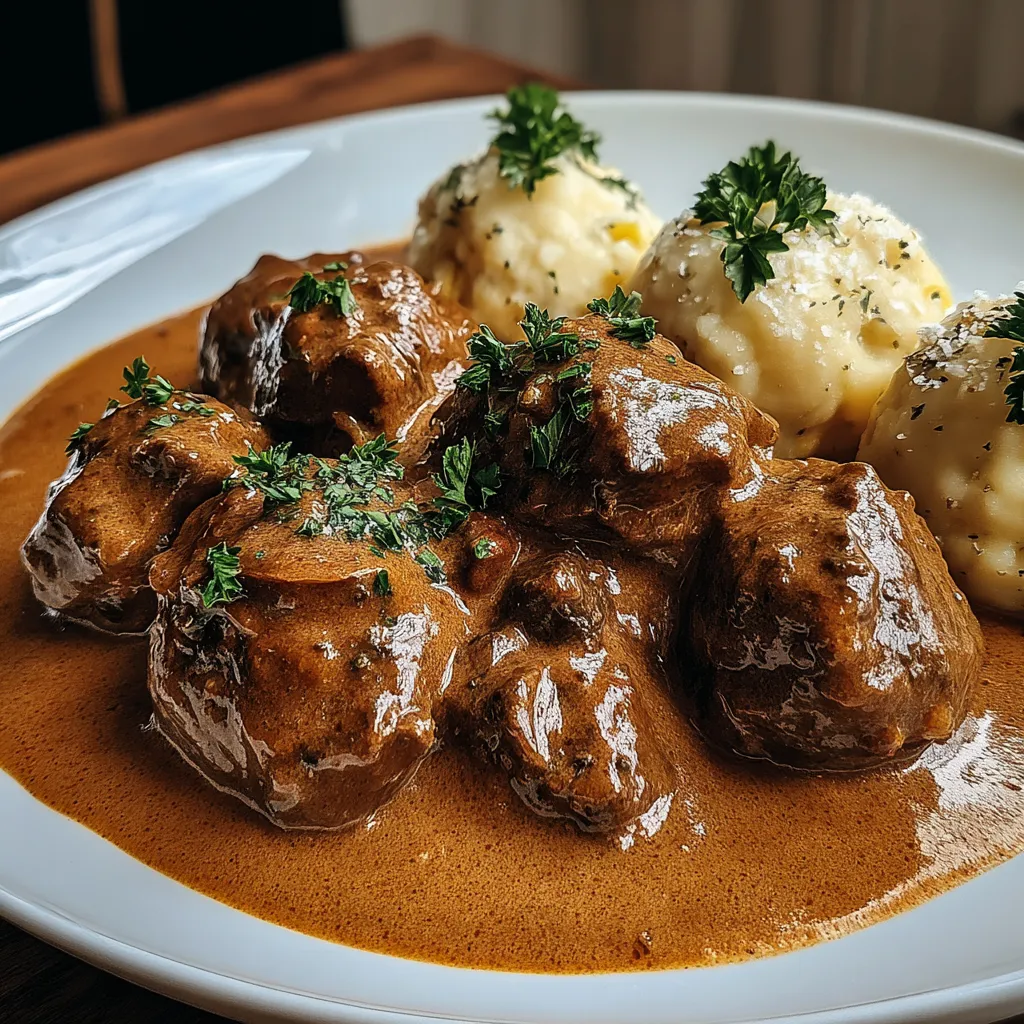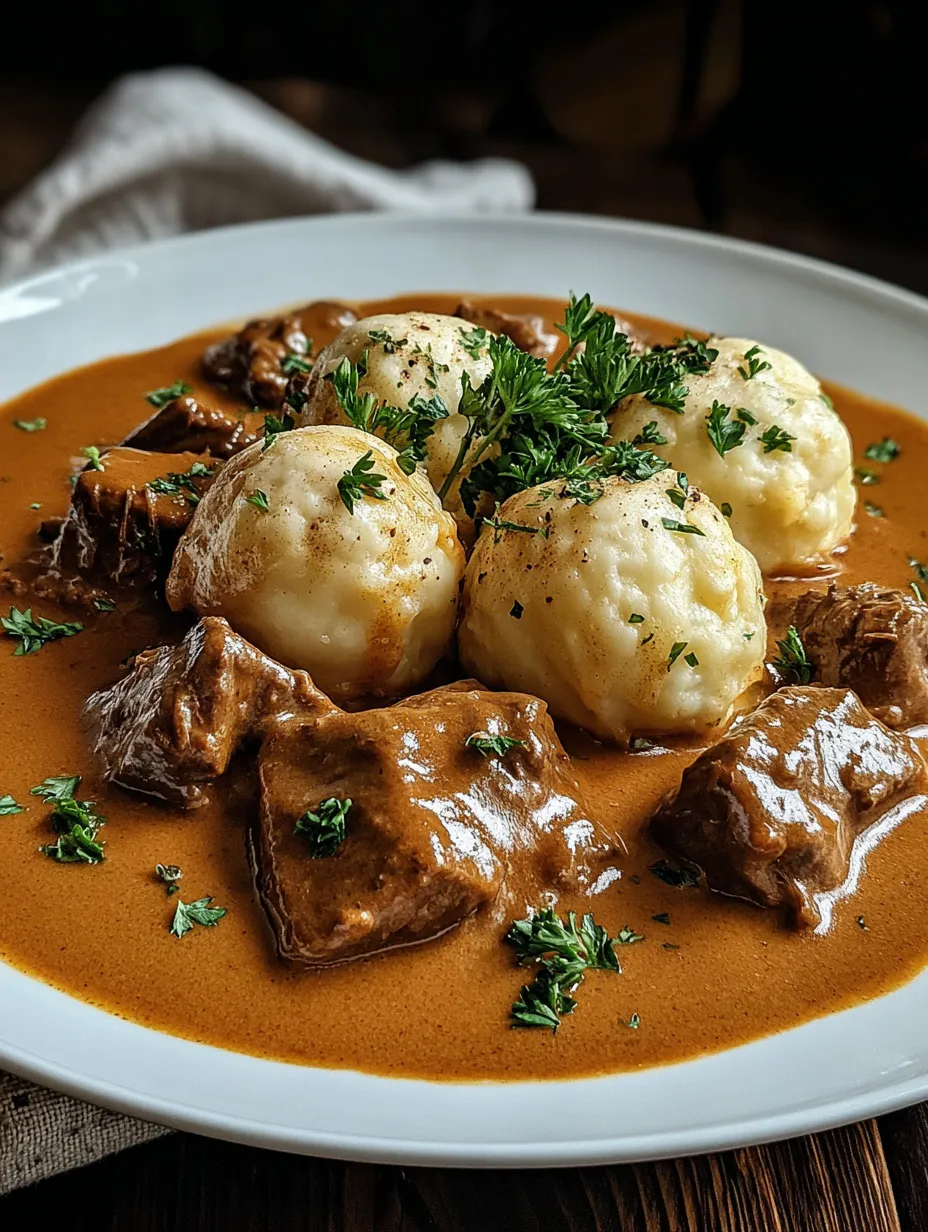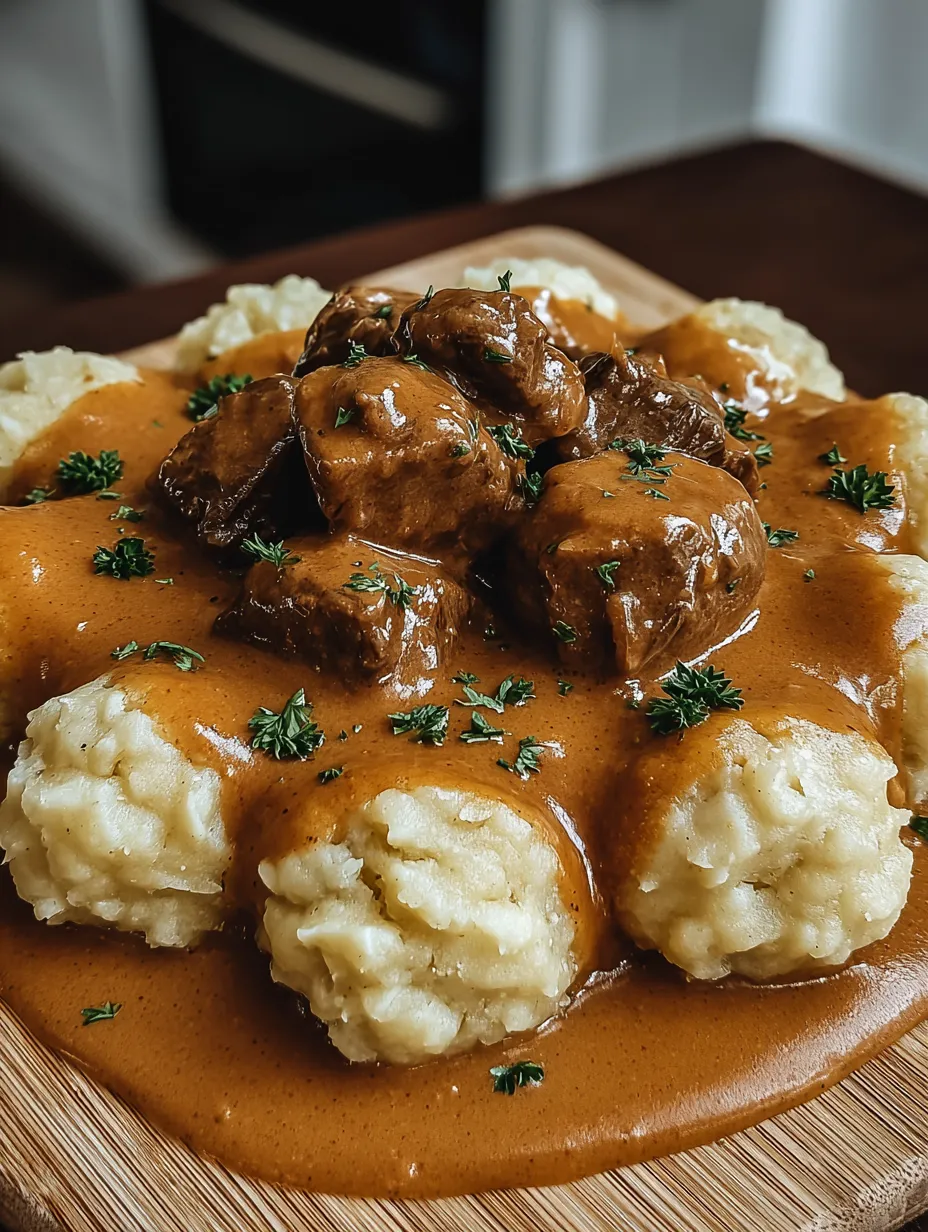 Save
Save
This creamy tender beef goulash with traditional bread dumplings has always been my go-to for cozy family gatherings and Sunday dinners. It is rich in flavor, comforting on cold days, and impresses everyone at the table with its unforgettable sauce and pillowy dumplings.
When I first made this creamy goulash for a birthday celebration it was an instant hit and now it is our must-cook dish whenever we want to spoil guests or just need a bit of extra comfort.
Ingredients
- Rindergulasch: shoulder or neck gives the best tender bite after slow cooking choose fresh bright red beef with some fat marbling
- Zwiebeln: use yellow onions for their mellow sweetness finely diced for an even cook
- Knoblauchzehen: fresh cloves bring gentle heat and aroma mince them for best distribution
- Tomatenmark: tomato paste adds body and a rich umami base opt for double concentrated for a punchier flavor
- Paprikapulver edelsüß: sweet smoked paprika for depth and classic goulash color pick a good Hungarian or Spanish brand
- Paprikapulver rosenscharf: optional hot paprika for a bit of extra warmth adjust to your heat preference
- Rinderbrühe: beef stock keeps it savory and rounds out flavors homemade or low sodium for control
- Sahne: cream for silky texture and soft taste use full fat for the creamiest result
- Mehl: flour thickens the sauce making it velvety look for unbleached for gentle thickening
- Pflanzenöl: neutral oil to brown the beef with a high smoke point like sunflower or canola
- Butterschmalz: clarified butter adds richness and a hint of old-style flavor
- Salz und Pfeffer: for balance and depth freshly ground black pepper makes all the difference
- Kümmel: optional caraway adds subtle warmth and an Alpine touch use whole seeds for best aroma
- Frische Petersilie: parsley for garnish brightens the dish always use fresh and chop just before serving
For the bread dumplings
- Weißbrot or Knödelbrot: stale white bread or knödel bread cubes for authentic texture choose bread with a firm crumb
- Milch: whole milk softens the bread and enriches flavor warm it slightly for better absorption
- Eier: eggs bind everything together for fluffiness pick large fresh eggs
- Zwiebel: yellow onion gives a sweet note sauté gently for mellow flavor
- Butter: for richness and golden color choose European style if available
- Petersilie: parsley brings lightness and a pop of green fold in chopped stems too for extra taste
- Salz und Pfeffer plus fresh Muskatnuss: salt and pepper for taste freshly grated nutmeg for authentic aroma
Step-by-Step Instructions
- Fleisch anbraten:
- Brown the beef in batches in a large pot using oil over high heat cooking until each piece is deep golden on all sides remove beef and set aside this step creates the deep savor at the heart of any great goulash
- Gemüse anbraten:
- In the same pot melt the clarified butter and gently cook onions and garlic over medium low heat stirring often until translucent and soft without browning this usually takes about ten minutes for all the flavor to release then stir in tomato paste and both types of paprika cook one minute more to develop color and aroma
- Fleisch zurück in den Topf:
- Return the browned beef with juices to the pot dust flour evenly over the meat and stir well until all pieces are coated this will help to later create a rich velvety sauce
- Brühe und Köcheln:
- Deglaze the pot by pouring in the beef stock scraping up accumulated browned bits reduce heat to very low add caraway if using and cover simmer for at least ninety minutes but up to two hours until the beef is fork tender occasionally check the pot and stir to prevent sticking
- Verfeinern:
- When the beef is buttery soft stir in cream gently bring back to a low boil then check and adjust seasoning with salt and black pepper simmer a few more minutes for everything to come together
- Garnieren:
- Scatter freshly chopped parsley over the finished dish just before serving to lift and brighten all the savory flavors

The sweet smoked paprika is my personal favorite ingredient because it adds warmth and depth without being overpowering. When I was a child my grandmother would let me sprinkle in the bright red paprika and I still remember how magical and fragrant the kitchen always smelled on goulash days.
Storage Tips
Cool any leftovers quickly then store the goulash in a sealed container in the fridge for up to four days. The flavors deepen overnight so it tastes even better the next day. It also freezes well for up to three months just thaw and gently reheat on the stove. Bread dumplings can be sliced and pan toasted from cold or even reheated in a gentle steam.
Ingredient Substitutions
If beef shoulder or neck is not available stewing beef or even pork shoulder works beautifully. For the dumplings any sturdy white bread that is a day or two old is perfect. A splash of sour cream can replace half the cream if you love a tangier note. No clarified butter Use unsalted butter and lower the heat slightly.
Serving Suggestions
Classic Rahmgulasch with bread dumplings is served family style straight from the pot alongside a crisp green salad and perhaps some pickled cucumbers for extra zing. It is also delicious with buttered noodles mashed potatoes or pillowy spaetzle if you feel like switching it up. Leftover dumplings can be sautéed in butter for a special lunch treat the next day.

Cultural and Historical Context
Rahmgulasch is a staple in Austrian and Central European kitchens known for its creamy sauce and slow-cooked beef. Every family has their twist but sweet paprika and time are always key. Serviettenknödel the bread dumplings steamed in a napkin are a distinct highlight of Austrian comfort cooking bringing people together around the table for generations.
Recipe FAQs
- → Wie wird das Rindfleisch besonders zart?
Wichtig ist, das Fleisch portionsweise scharf anzubraten und es anschließend bei niedriger Hitze lange zu schmoren. So bleibt es saftig und zart.
- → Kann ich andere Fleischsorten verwenden?
Rind eignet sich am besten, aber auch Kalb oder Schwein können eingesetzt werden. Die Schmorzeit muss dann ggf. angepasst werden.
- → Wie gelingt die cremige Sauce?
Die Kombination aus Tomatenmark, Paprikapulver, Brühe und Sahne sorgt für eine sämige, aromatische Sauce. Mehl bindet zusätzlich.
- → Wodurch werden Serviettenknödel locker?
Altbackenes Brot, Eier und ausreichend Milch schaffen eine lockere Textur. Wichtig ist, die Masse nicht zu fest zu drücken.
- → Kann ich das Gericht vorbereiten?
Ja, Gulasch lässt sich sehr gut vorbereiten und schmeckt nach dem Aufwärmen oft noch aromatischer. Knödel lassen sich vorab zubereiten und aufschneiden.
